The United States Forest Service, an agency of the U.S. Department of Agriculture (USDA), and the Oregon City, Oregon-based Softwood Lumber Board (SLB) have announced the six winning proposals in the $2 million design competition, Mass Timber Competition: Building to Net-Zero Carbon. The winning submissions—all of which “exemplified capabilities to design and construct mass timber buildings in the U.S. that are repeatable and scalable”—were revealed at a press conference held last week at the 2022 AIA Conference on Architecture in Chicago. Hartshorne Plunkard Architects, ZGF Architects, and LEVER Architecture are just a handful of firms that comprised the winning project teams. Not surprisingly, Pacific Northwest-based projects dominate the list, joined by winning submissions for mass timber efforts in Ohio, New York, and Colorado.
Launched last October with the submissions period opening in February, this is the second national timber design competition launched in partnership between by the USDA and SLB. The nonprofit WoodWorks managed all aspects of the competition, which aimed to “showcase mass timber’s innovative applications in architectural design and highlight its significant role in reducing the carbon footprint of the built environment.”
A wide range of building types—commercial, institutional, educational, industrial, mixed-use, and affordable multifamily housing developments—were eligible for submission so long as the timber sourced for the project demonstrates sustainable forest management and contributes to forest and watershed health. Single-family homes were not eligible and evaluation preference was given to typologies in which timber construction is largely underrepresented including healthcare facilities, large warehouse distribution centers, big-box retailers, and tall buildings ranging from 6 to 18 stories. Hybrid projects incorporating other structural building materials were also eligible provided that timber products—preferably domestically manufactured—such as cross-laminated timber (CLT), nail-laminated timber (NLT), glued-laminated timber (glulam), and dowel-laminated timber (DLT) are the dominant components used.
Winning teams will receive up to $500,000 in grant funding, enabling them to design and build their respective projects. As noted in a press announcement, the winners must provide quarterly updates to keep stakeholders abreast of their progress, and payouts of competitions funds will correspond to each project’s progress as reported. “Lessons learned from the competition projects will be shared with the broader design and construction community to help support future projects, including cost analyses, life cycle assessments, and other research results,” the announcement elaborated.
“The SLB is gratified to see the breadth of concepts and building typologies entered in the competition. With nearly 60 submissions, we saw excellent examples of the innovative designs mass timber makes possible,” said SLB Chief Marketing Officer Ryan Flom in a press statement. “These six winning designs will serve to advance not just our body of knowledge for mass timber construction, they will inform the growing shift towards building for occupancy well-being, resilience and a minimal carbon footprint.”
Without further ado, below are the six winning proposals. Detailed are building type along with the full project team followed by a description and information about each respective project’s carbon impact as provided by the SLB.
Following that is a list of the members that made up the competition judging panel.
Vancouver Ambulatory Care Center | Vancouver, Washington
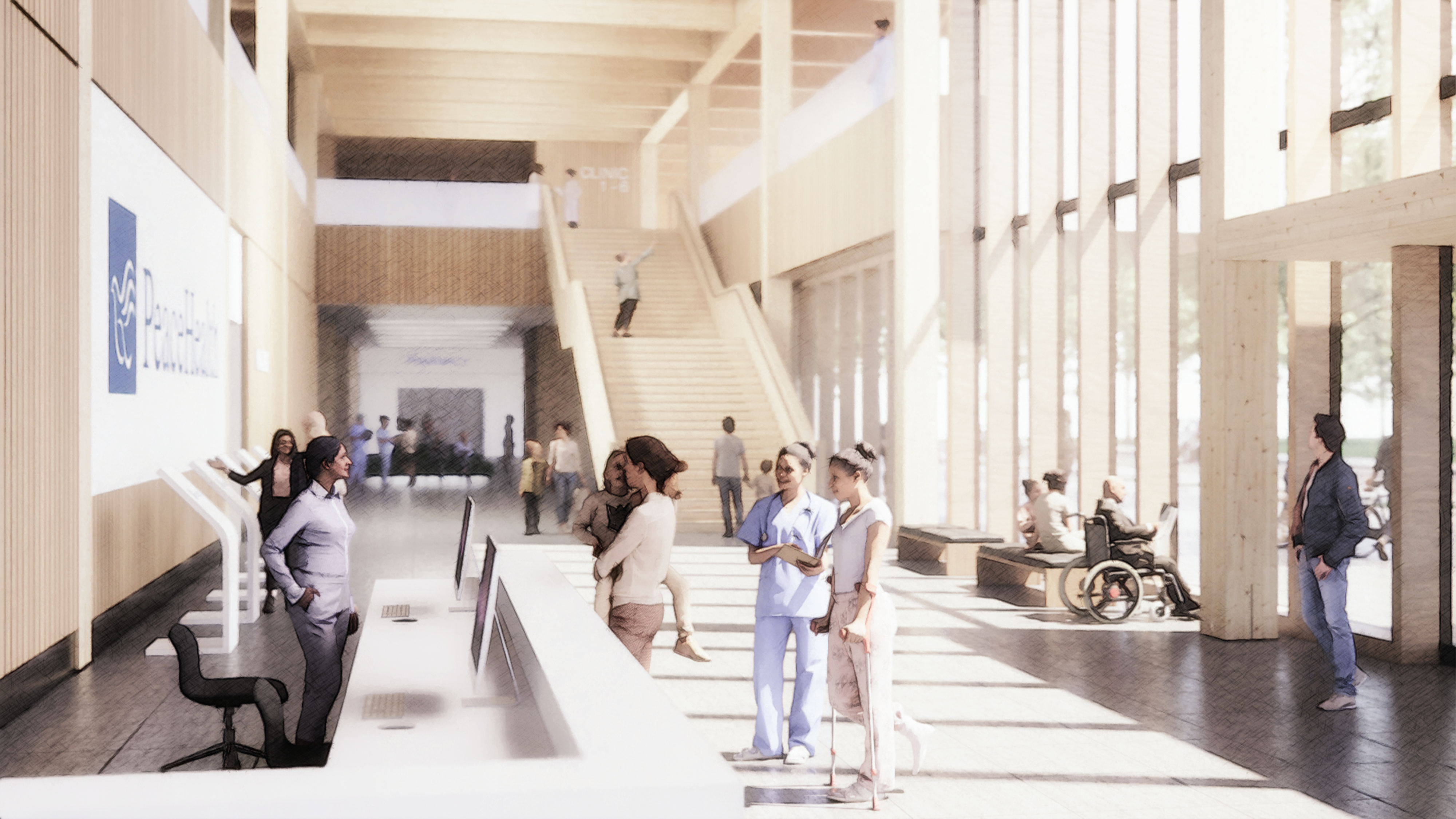
Medical center
ZGF Architects, Timberlab, Swinerton, and PCS Structural Solutions
Project description: “PeaceHealth is a not-for-profit Catholic healthcare system based in the Pacific Northwest. Their overarching goal for the new medical center is to provide outpatient ambulatory medical care focused on an innovative experience for patients and caregivers. By creating an inviting campus that promotes community health and wellness, Vancouver Ambulatory Care Center can support community education, gathering spaces, and partnerships with local organizations and businesses. This includes opportunities for education and collaboration with nearby schools. PeaceHealth’s founding Sisters of St. Joseph of Peace first arrived on the West Coast to build a hospital to care for loggers, mill workers, fishermen, and their families. Since their first encounter with the timber industry in 1890, the industry has come a long way in developing new and innovative ways to source and build with wood. Thus, consideration for a mass timber structural system is deeply rooted in the project’s cultural history. Set on a 12.5-acre greenfield site at the eastern portion of Vancouver, Washington, the new medical center will be located at the corner of SE 192nd and SE 1st Street. The 176,000 square foot, four-story building will employ cross-laminated timber (CLT) panels and glue-laminated timber (glulam) throughout. A key deliverable from this effort will be a typology-specific comprehensive barrier-breaking type resource guide developed by the design team.”
Carbon impact: “A structural LCA that was conducted using the conceptual estimate shows a 1.6 million kgCO2e savings for the mass timber over the steel structure. When considering the biogenic storage benefits of wood with an industry standard assumption for end-of-life scenarios from Tally LCA software, an additional 1.6 million kgCO2e savings is realized.”
Return to Form | Denver
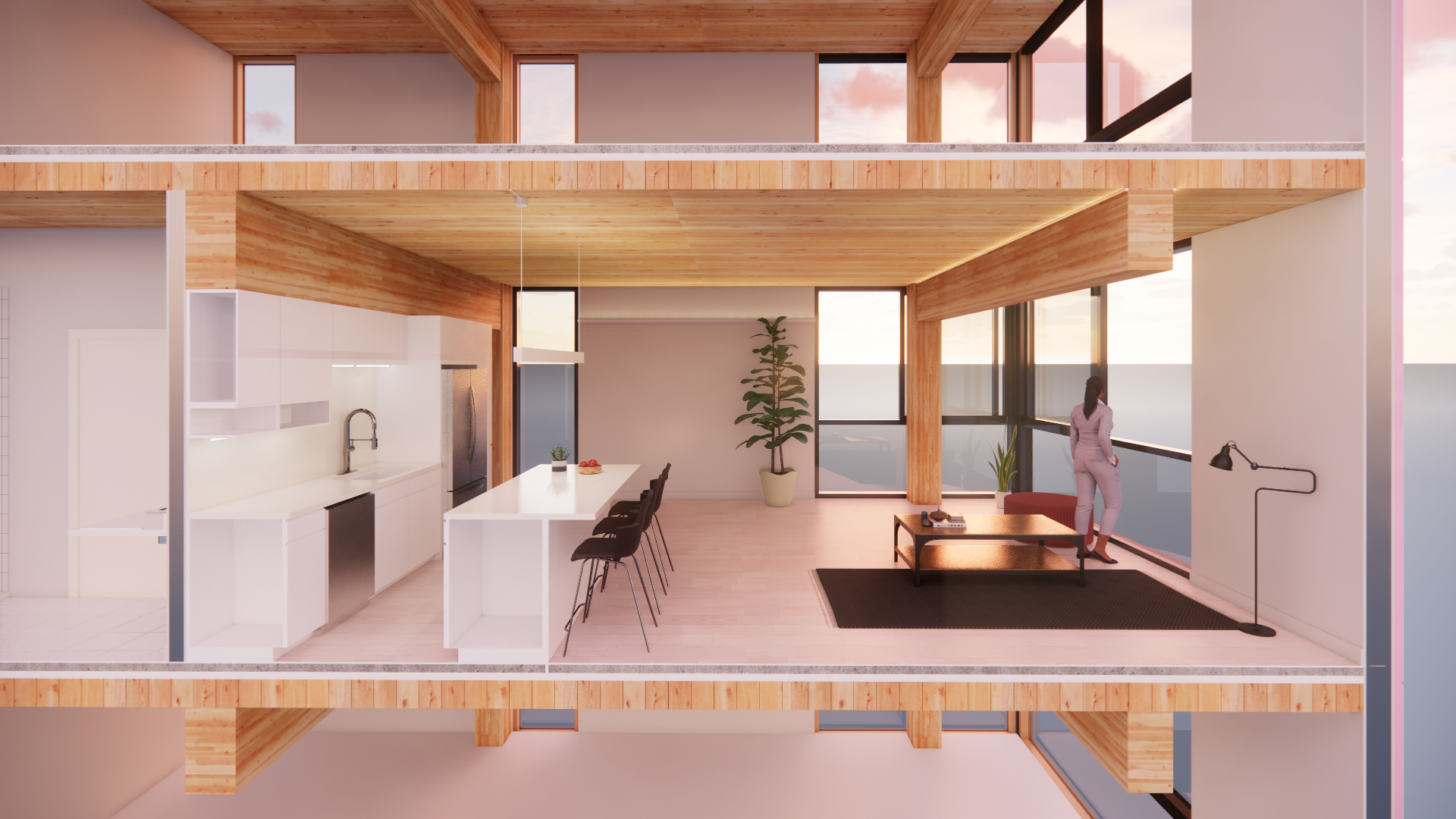
High rise multifamily w/ affordable housing units
Katz Development, Timberlab, KL&A Engineers and Builders, and Tres Birds
Project description: “Return to Form is a high-rise multifamily project located in the heart of the River North Art District (RiNo) of Downtown Denver. The project will be the first mass timber multifamily building in the state of Colorado. Formerly a warehouse district, RiNo has seen dramatic public and private investment as Denver has continued its explosive growth. The 12- story building will house 84 high-end apartment units, resident amenity space, and ground floor retail. The project will consist of nine levels of mass timber sitting above a three-level concrete podium. The mass timber structure will hold residential units on levels 4-11 and will feature a planted rooftop amenity and four Penthouse units on the 12th floor. The mass timber structure will be composed of glulam columns and beams with CLT decks. This project seeks to demonstrate the value and success that can be achieved by the local proactive adoption of the most current building codes.”
Carbon impact: “The team will provide both carbon reduction and storage benefits through “Carbon Impact Reports,” updated throughout the design process.”
Evergreen Charter School | Hempstead, New York
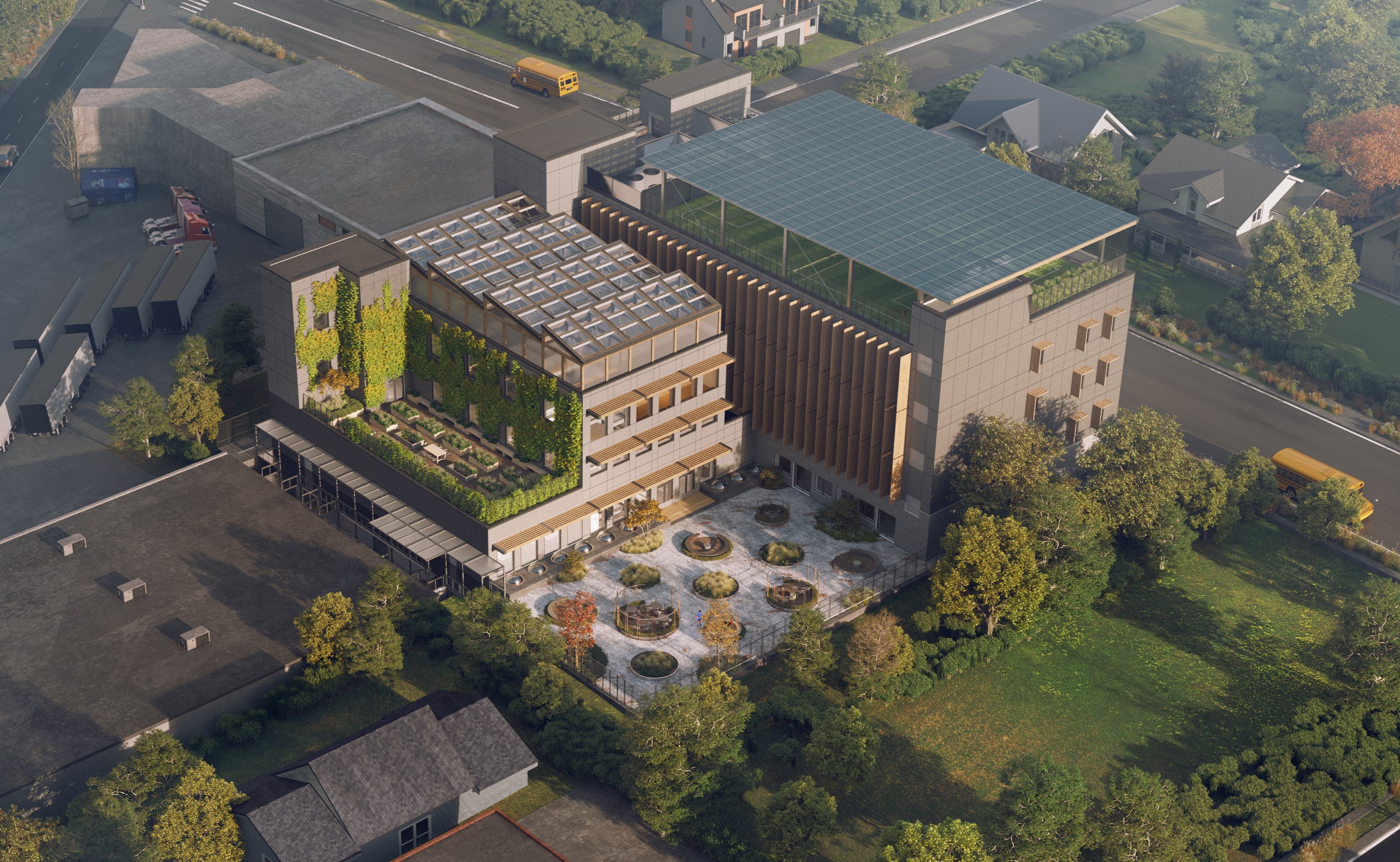
School
Martin Hopp Architect, Consigli, and Odeh Engineers
Project description: “As one of the first Mass Timber K-12 Charter School projects in the Tri-State Area, Evergreen Charter School is a flagship 85,000 square foot, 750 student K-12 project for a mission driven Charter School Organization based in a low-income Hispanic community in Hempstead, Long Island. Evergreen is focused on building sustainable communities with sustainable carbon footprints. As a school focused on social uplift and providing key community infrastructure in a marginalized neighborhood, the project follows an ambitious agenda in both introducing sustainable design goals and implementing far-ranging community facilities within a limited cost constraint – serving as an important, replicable proof of concept demonstrating that design excellence, and Mass Timber, need not be out of reach for clients working with modest budgets. The school itself is a five-story hybrid CLT building, with accessible multi-purpose and green roofs, where a creative stepped concrete podium design mixing construction type I-A with a hybrid CLT construction type III-B is being used to achieve a five-story design. This project intends to prove out that all students can have access to a warm, welcoming and aesthetically pleasing learning environment by utilizing the structure itself to deliver that result, being competitive with a low budget vanilla box.”
Carbon impact: “A schematic level, early-stage Carbon Analysis using the Woodworks Carbon Calculator indicates that for the 36,666 cubic feet of CLT used in the building, the project will avoid 359 metric tons of CO2 emissions by substituting Mass Timber. The volume of wood used in the project represents only 0.00057 percent of the annual forest growth in North America. Further, another 928 metric tons of CO2 is being sequestered in the wood for a net carbon benefit of 1287 metric tons of CO2.”
Alaskan Copper & Brass | Kent, Washington
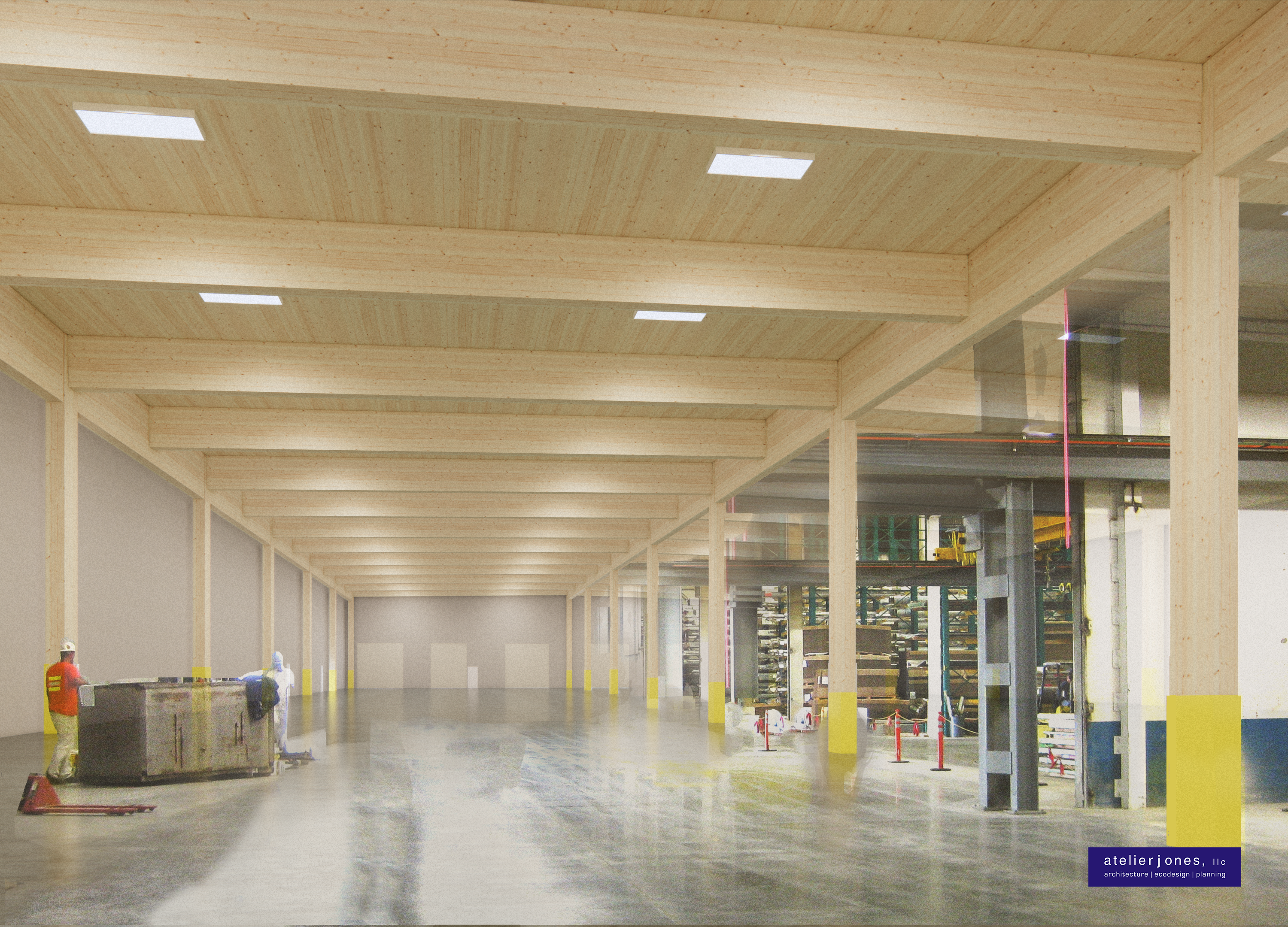
Warehouse
atelierjones, Foushée, Timberlab, and DCI Engineers
Project description: “Alaskan Copper & Brass Company’s (ACB) proposed project is a 42,456-square-foot industrial warehouse building. ACB’s operations in South Seattle are farther from their employee’s homes than their Kent Facility. Adding another building to their Kent Campus will reduce commute times and transportation, parking, and transit expenses for their current and future employees. In addition to employee benefits, this would be the first warehouse to incorporate mass timber on a large scale to a shell and core warehouse project in the Kent Valley, which has been dominated by traditional tilt-up concrete/bar-joist and pre-engineered metal buildings. The one-story warehouse will be built with CLT panels and glulam beams and columns. The focus of this effort is to evaluate multiple all wood and wood-hybrid structural systems to identify cost competitive options to traditional forms of construction in this building type with the goal of providing developers a more sustainable option to build that will reduce their carbon footprint.”
Carbon impact: “An initial comparative carbon impact analysis of this project demonstrates a 33 percent reduction emissions for an equivalent warehouse with a CLT enclosure over a concrete tilt up baseline.”
INTRO Cleveland Phase 2 | Cleveland
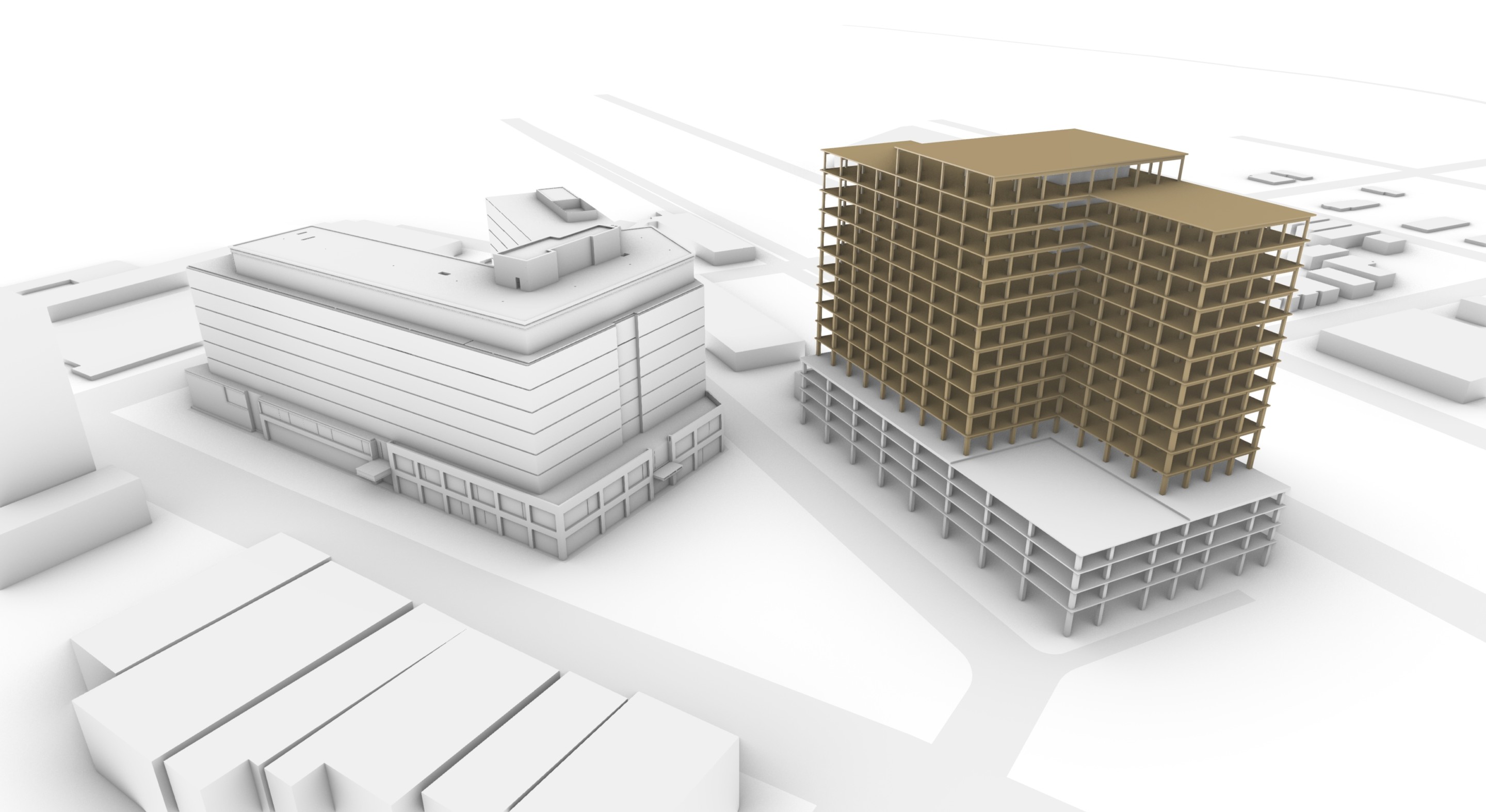
High rise multifamily
Harbor Bay Real Estate Advisors, Hartshorne Plunkard Architecture, and Forefront Structural Engineers
Project description: “INTRO Phase 1 is a 750,000-square-foot mixed-use development that is the largest mass timber project in the country. INTRO Phase 2 will expand upon the success of Phase 1 by building a 16-story mass timber building that focuses on additional residential space. A future Phase 3 project will also bring additional office space in order to truly create a “walkable” neighborhood where one can work, live, and enrich the local community simultaneously. The Phase 2 Project will be a mass timber tower over a concrete podium. The mass timber tower will consist of glulam columns and girders with CLT floor slabs. Wood is estimated to comprise 50 percent of the total structure. Design and construction efficiencies will be shared with the design and construction community to further advance the viability and cost competitiveness of mass timber in this building type application.”
Carbon impact: “With carbon stored in the timber and avoided carbon emissions, the carbon benefit is 6,483 metric tons of carbon dioxide in Phase 2 of INTRO, according to the WoodWorks Carbon Calculator. A comparative carbon impact analysis of this project demonstrates a 39 percent – 56 percent reduction in embodied carbon.”
Killingsworth | Portland, Oregon
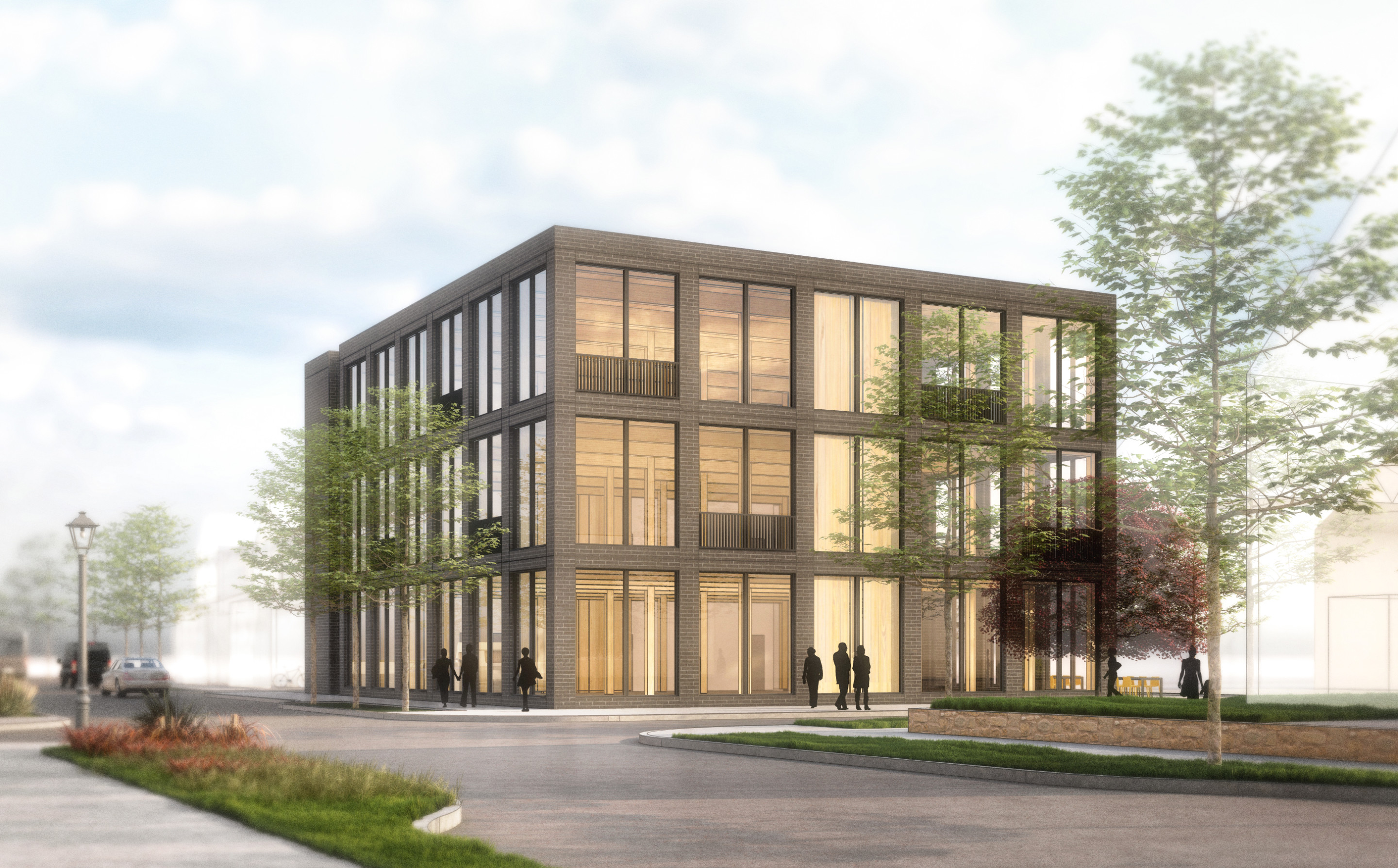
Community-centric office space
Adre, LEVER Architecture, and Holmes US
Project description: “Killingsworth is a three story 18,780-square-foot building, which is exclusively used as a creative office space. Amenities include bike parking and showers, and expansive terraces and ground floor courtyard. Located in Northeast Portland’s King neighborhood, the project site is three and a half miles from Downtown Portland, Oregon. The King neighborhood sits within the historic greater Albina neighborhood of Portland, the home of a thriving African American community post World War II. The area suffered from many of Portland’s discriminatory lending practices, including redlining, which contributed to the lack of investment in the neighborhood for the latter half of the 20th century. Given this, the site falls within the U.S. Small Business Administration (SBA) HUBZone which is intended to fuel small business growth in a historically underutilized zone. The project is intended to create an inclusive work environment and to house businesses that value diversity, equity, and community wellness. The project will promote social equity with a goal of 30 percent of the subcontractors building the project to be BIPOC- and women-owned businesses. Additionally, the development team has a goal of 50 percent of the project’s equity obtained from women and/or people of color. The goal of this structural design is to prove out the rocking shear wall system and become a demonstration project of how this advanced technology can exceed code and provide a cost-effective seismic solution for buildings between three and 12 stories.”
Carbon impact: “Using mass timber for Killingsworth results in a carbon benefit of 407 metric tons of carbon dioxide. This is equal to taking 86 cars off the road for a year.”
Judging panel
Joe Allbright, Senior Director of Corporate Real Estate, Walmart; Ted Black, Utah State Fire Marshal; Kathryn Fernholz, President/CEO, Dovetail Partners; Julia Gisewite, Chief Sustainability Officer, Turner Construction Company; Tim Gokhman, Managing Director, New Land Enterprises; Jordan Komp, P.E., S.E., Vice President and MKE Office Director, Thornton Tomasetti; Anne Schopf, Director of Design, Mahlum; Wil V. Srubar III, Associate Professor, University of Colorado Boulder; Joe Vaughn, Key Account Manager, Natural Capital Exchange, NCX.











